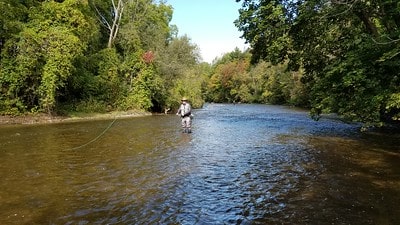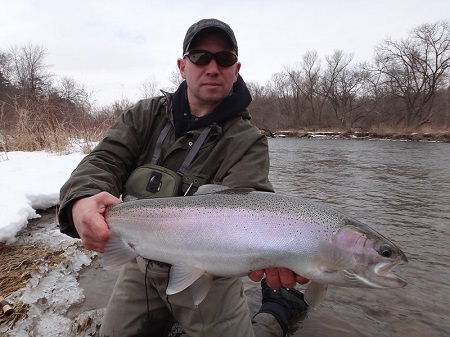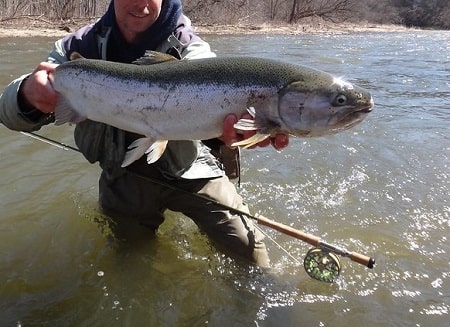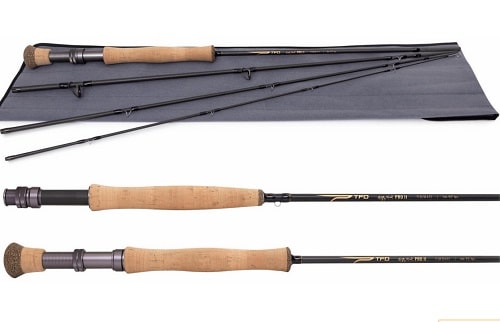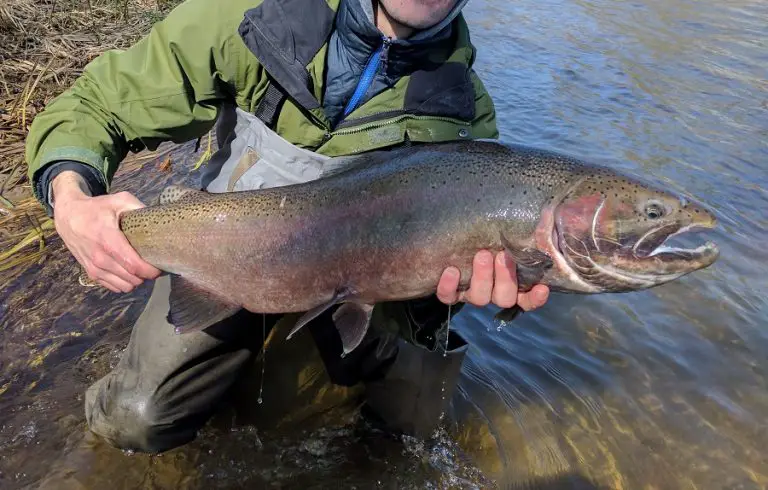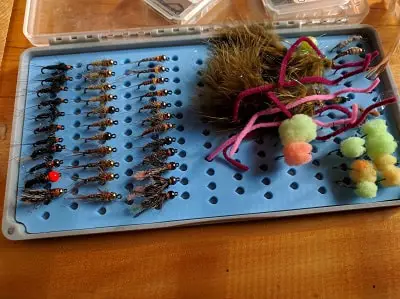Drift Fishing For Steelhead: Best Methods, Set-ups And Baits
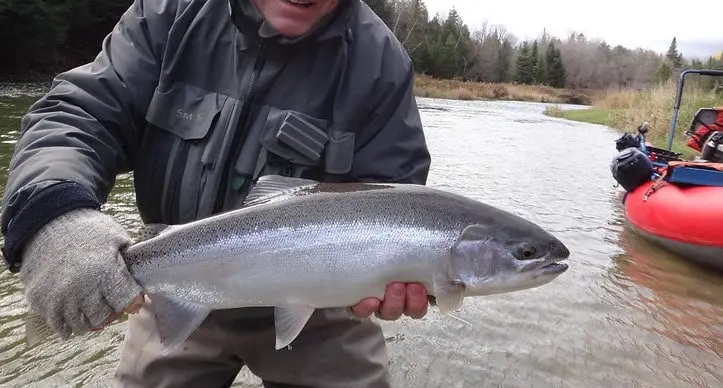
Drift fishing for steelhead involves casting out your bait with only enough weight that to sink your bait to the bottom while still allowing the bait to drift and bounce naturally along the bottom. Drift fishing allows you to fish far away from you and allows you to fish very deep if you need to.
Key Takeaways
- Gear: Use the right drift fishing gear for steelhead, which includes suitable rods and reels for drift fishing. Many anglers will use eight-foot to eleven-foot rods that are medium light to medium heavy.
- Line: Using the best line for drift fishing will enable you to cast farther, get better drifts, and detect bites better. Most anglers will use monofilament lines, but braided lines, and full fluorocarbon lines work great.
- Leader Setup: The key with any fishing method for steelhead is using the proper setup and leaders. I’ll show you them below.
- Best Hooks: I and other guides use proven hooks that have a high hooking and holding percentage. The best hooks for drift fishing are Raven Specimen and Gamakatzu Octopus hooks. Sizes depend on the bait you are using, but most anglers use sizes 4 to 8.
- Baits: The best baits for drift fishing are often the same ones used for other methods. Spawn bags, beads, pink and red plastic worms, and skein are good options.
- Best Water: Learning the best type of water to drift fish for steelhead can improve your catch rates. Drift fishing excels in faster currents and deeper water over 10 feet.
- I will discuss shallow-water drift fishing methods and deep-water drift fishing methods.
- Detecting Bites and Bottom: Detecting the bottom and detecting a strike is often the most challenging part of using this method. I will give you some helpful tips on how to do this better.
Weights For The Drift Fishing Setup
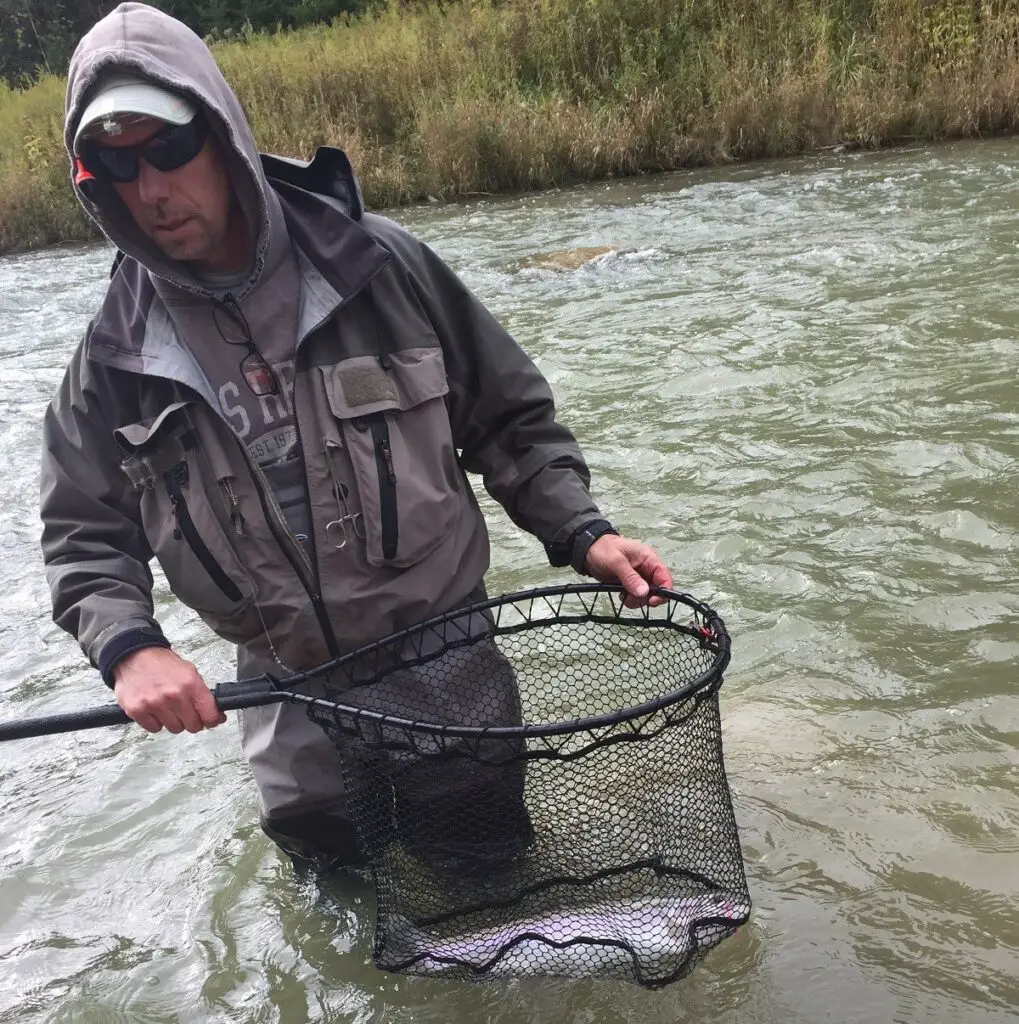
Basic drift fishing is simple because it primarily involves a line, leader, weights, and bait, yet it can be a challenging method to master if you want it to be more effective.
The drift fishing technique involves using enough weight to sink your bait to the bottom, but too much bait will impede a natural drift, and too little weight will prevent you from getting your bait deep and in the strike zone.
You will need to change the weight based on the velocity and depth of the water. Doing so requires learning how to detect the bottom.
Steelhead are generally hard to fish in very large and deep rivers since they spend most of their time at the river bottom, and it’s difficult to get your baits deep enough with a float or other fishing methods. Therefore, drift fishing is the ideal tried-and-true fishing method for capturing steelhead.
The trick is to pay keen attention to your line to determine if you are on the bottom and if it’s moving with the current. Watching your line closely is also important to detect a bite.
Drift Fishing Equipment
In addition, you also need the right gear for drift fishing in rivers. The right gear, which includes the right line, will help you notice the slightest bite from steelhead and the ability to read drift.
Fishing Rods For Drift Fishing
Generally, fishing rods that are designed for drift fishing steelhead come in either bait cast or spinning rod designs, and they are longer than 9 feet. Your fishing rod must be strong enough to hold an 8- to 14-pound mainline and still be sensitive enough to feel the bottom and the lightest bite.
When choosing a fishing rod, here are factors you need to consider:
Most good drift-fishing steelhead rods are between nine and eleven feet long.
Longer rods might be difficult to cast in tight fishing situations, but a rod of 8.5-foot or longer improves casting distance, allows you to keep the line off the water and have better line control, and the longer rod acts like a big shock absorber which allows you to fish with lighter leaders which are often required when fishing for steelhead.
For drift fishing on very large rivers and for fighting and landing a steelhead, it is best to use a rod rated for 8 to 16 pounds, but for smaller rivers, rods rated for 4 to 10 pounds are better. I discuss the best steelhead rods HERE.
Reels For Steelhead Drift Fishing
Reels are crucial because you need one that allows you to let line out as the bait drifts down the river. The reel you choose should be compatible with the rod you intend to use.
Baitcasting reels are commonly used for steelhead drift fishing on the larger rivers and on the west coast rivers. They are also called level wind reels. Casting a level wind reel requires some practice, but it gives the finest type of drift fishing control once mastered.
Spinning reels are also used for drift fishing and are popular in the Great Lakes region. They can also be utilized for other types of fishing, such as throwing light lures and float fishing.
Bait Casting Reels For Drift Fishing
Drift fishing, which includes tossing a bait upstream and letting it drift downstream naturally, is one of the most efficient steelhead fishing strategies. However, baitcasting reels are recommended for drift fishing because they improve casting accuracy and line control.
The open spool on the reel makes it easy to manage the quantity of line released from the reel and the speed at which the line comes out after throwing the bait upstream.
It also lets you adjust the free spool for better and longer drifts, increasing the amount of time your bait spends in the strike zone.
The entire efficiency of the baitcasting reel can be improved by matching the reel with a suitable baitcasting rod. You should be sure that you use a rod that is made for a baitcasting reel and not a spinning reel.
Baitcasting reels come in different forms and sizes to meet a variety of steelhead fishing situations. Smaller reels are suitable for smaller-sized rivers, whereas larger reels would be suitable for large rivers.
Spinning Reels For Drift Fishing
Many anglers use spinning reels because they cast well, and you can leave the bail open and feed the line out.
Using a spinning reel suitable for fishing for big steelhead is important. This means that your reel should be able to hold a lot of line between 8 and 14 pounds and have a smooth and durable drag system.
I discuss the best steelhead reels, from economy-priced reels to high-end reels at, Best Reels For Steelhead.
Best Drift Fishing Lines For Steelhead
For example, in bigger rivers, a heavier line of 10 to 14-pound test is best. Use a smaller line of 8 to 10 pounds in smaller steelhead rivers with clear water.
Not many anglers realize this, but thinner lines sink faster and do not get pushed around as easily by the current, which allows you to get your bait down faster and then get a more controlled and better presentation.
Most anglers, myself included, use monofilament lines when drifting for steelhead.
I also prefer bright-colored lines that can be seen from a distance because when drifting fishing for steelhead, it’s very important to see the line for both bottom detection and strike detection. With bright-colored fishing lines and also with clear lines, you should always use a leader.
Braided lines of 14 to 30 pounds are also very good.
The Drift Fishing Leader Setup Suitable For Steelhead
These are a few good leader setups for drift fishing that I use.
With this setup, you can use a few different types of weights, which I discuss below, and you should adjust your leader size based on the conditions.
I would use a six- or eight-pound leader in smaller Great Lakes streams that are less than thirty feet wide and are very clear.
For larger rivers that are 40 to 100 feet wide, I would likely upsize to an 8 to 12-pound fluorocarbon leader, but I would only go as heavy as I can get away with and would prefer to keep it as light as possible because leaders that are too thick could be seen and avoided by steelhead, especially on slower and clearer water.
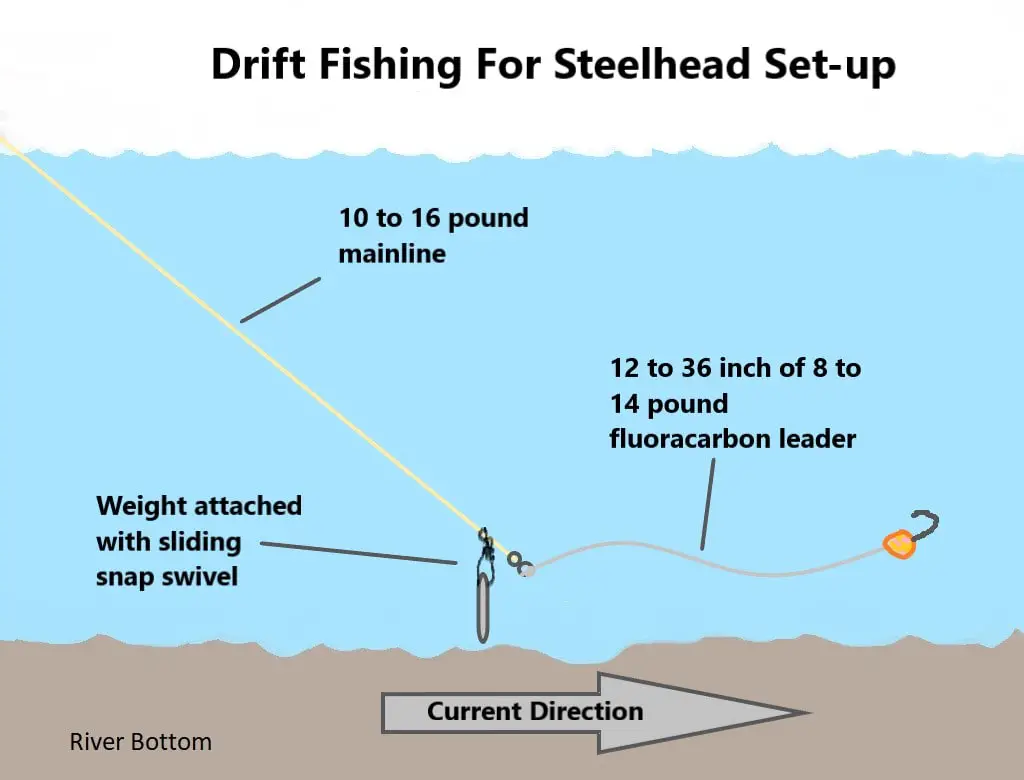
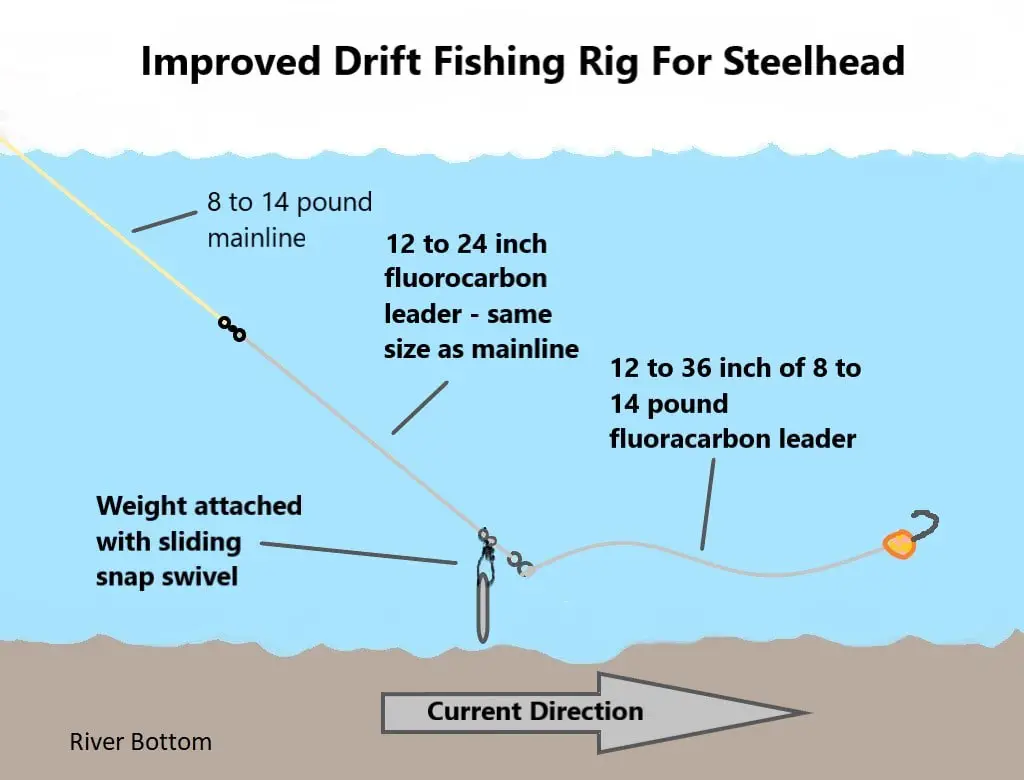
Swivels For Drift Fishing
A lightweight leader is attached to a heavier mainline using barrel swivels. This enables you to swiftly adapt your rig to changing sea conditions and reduce mainline snag loss.
Lead For Steelhead Drift Fishing
For steelhead fishing, there are various ways to hook up your lead. First, ensure the lead is straight to avoid line twists and bottom hang-ups. Otherwise, it will twirl in the current. You should also hook your lead on with a snap swivel or 3-way swivel.
Pencil Lead
Pencil lead is the most common and cost-effective lead for drift fishing. Its diameters are 1/8, 3/16, and 1/4 inches, and all can be used for medium to fast currents.
To use a pencil lead, cut off the desired length, which can be one to four inches. The length will depend on the depth. Then pinch one end flat and poke a hole in it with a nail or hole punch. You can see it in this VIDEO.
The Slinky
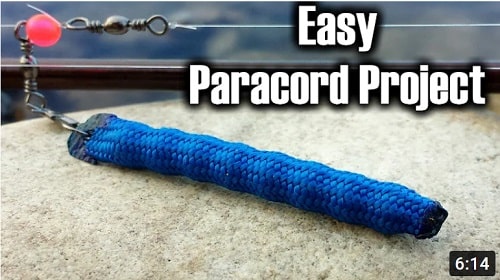
A slinky is a different form of lead weight. A slinky is a collection of split shot weights or lead shots wrapped in parachute rope.
The slinky rig can be as short as a half inch or as long as a few inches, and this long, slender profile enables the lead to bend and slip over rocks without being tangled as frequently.
Due to the general elasticity of the rope, a slinky does not have the exact sharp bottom feel like a straight lead, and therefore, it may be harder to detect the bottom.
Some guys will also make slinkies out of surgical tubing packed with lead shots. To see how slinkies are made, watch this video.
Deeper And Bigger Water
Steelhead are resourceful, so they will not use energy fighting the rapids. In the frigid winter months, it also means they preserve energy by keeping near the bottom. Unless the conditions are ideal, fishing in shallow water can be a waste of time.
This is why you are more likely to find steelhead in deep pools, deep runs, and in larger sections of the river, which is where drift fishing works well.
The advantage to drift fishing is you can fish 3 feet deep or 30 feet deep, all you need to do is add enough weight and to detect the bottom so you know when you are deep enough and then allow your rig to drift with the current.
Detecting Bottom
Detecting the bottom is one of the most important things to learn how to do well when drift fishing for steelhead.
You do this by watching your line closely. If you do not have enough weight, your line will drift down the river smoothly. If you hit bottom, the line will catch and will stop or twitch as your bait bumps bottom.
Your line should be periodically twitching and lightly bouncing, and it should always be moving at the speed of the current.
If the line keeps stopping, then you know it is hanging up on the bottom or a fish has grabbed your bait.
If it keeps grabbing the bottom, you probably have too much weight.
Good anglers with good rods may also be able to feel the light ticks as the weights bounce across the bottom. Many anglers will also hold the line just above the reel with there their thumb and index finger. Holding the line might enable you to feel the ticks and taps as the weights bump the bottom.
Detecting A Bite
Many new anglers struggle with detecting a bite, but with practice, it will become easier. Detecting a strike requires watching the line near the water’s surface like a hawk.
The line should always be moving around the same speed as the current, and if it stops for more than a second, you should set the hook as this could be a bite. If nothing is there, you can let it drift.
Also, you should set the hook if you feel any pulling or see the line straighten abruptly.
I believe a lot of anglers miss bites with the drift fishing method, which is why I don’t use it often and why other good anglers and I prefer to use a float whenever possible.
Float fishing is almost always the most effective way to catch steelhead in a river. You can see how to do it on my page, Float Fishing For Steelhead.
Hire A Drift Fishing Guide
It might take years to master and you might waste plenty of time trying to figure it all out. The basic guidelines discussed above will help with drift fishing, but it’s critical to remember that each river is unique.
If you continue to struggle with drift fishing, do your homework and choose a good drift fishing guide that has spent a considerable amount of time drift fishing.
Best Baits
Spawn / Roe- This is the most popular steelhead bait, but it is not necessarily the best.
Worms – Plastic and real worms can outperform roe under the right circumstances.
Beads – A tiny bead that looks like a salmon or steelhead egg can be precisely what the steelhead is looking for, and it can be the ideal steelhead bait.
Flies – Some flies are excellent steelhead bait and can even be the finest bait.
If you have a question, comment, or some advice about fishing for steelhead with the drift fishing method, let me know in the comments section below.
Tight Lines
Graham

